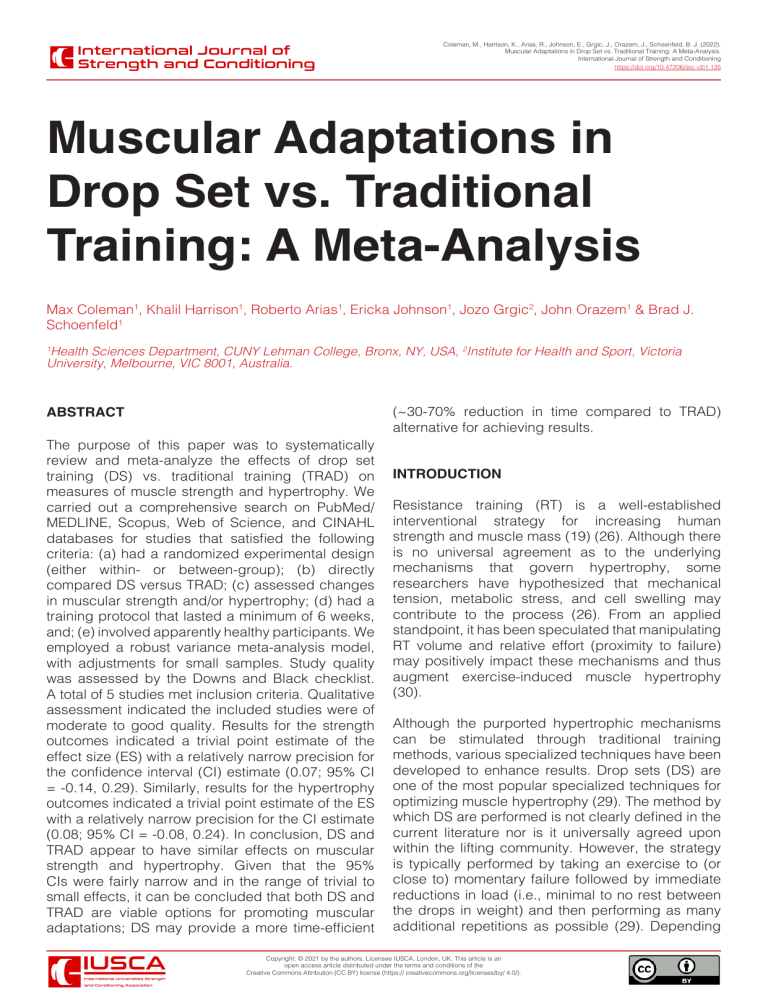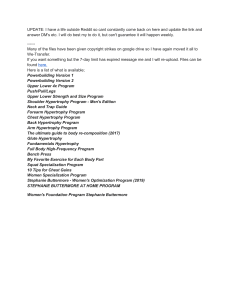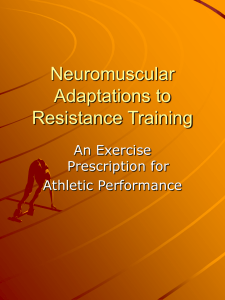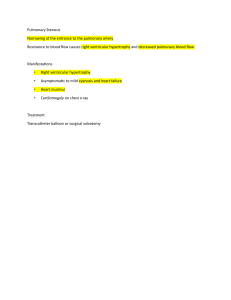
Coleman, M., Harrison, K., Arias, R., Johnson, E., Grgic, J., Orazem, J., Schoenfeld, B. J. (2022). Muscular Adaptations in Drop Set vs. Traditional Training: A Meta-Analysis. International Journal of Strength and Conditioning https://doi.org/10.47206/ijsc.v2i1.135 Muscular Adaptations in Drop Set vs. Traditional Training: A Meta-Analysis Max Coleman1, Khalil Harrison1, Roberto Arias1, Ericka Johnson1, Jozo Grgic2, John Orazem1 & Brad J. Schoenfeld1 Health Sciences Department, CUNY Lehman College, Bronx, NY, USA, 2Institute for Health and Sport, Victoria University, Melbourne, VIC 8001, Australia. 1 ABSTRACT The purpose of this paper was to systematically review and meta-analyze the effects of drop set training (DS) vs. traditional training (TRAD) on measures of muscle strength and hypertrophy. We carried out a comprehensive search on PubMed/ MEDLINE, Scopus, Web of Science, and CINAHL databases for studies that satisfied the following criteria: (a) had a randomized experimental design (either within- or between-group); (b) directly compared DS versus TRAD; (c) assessed changes in muscular strength and/or hypertrophy; (d) had a training protocol that lasted a minimum of 6 weeks, and; (e) involved apparently healthy participants. We employed a robust variance meta-analysis model, with adjustments for small samples. Study quality was assessed by the Downs and Black checklist. A total of 5 studies met inclusion criteria. Qualitative assessment indicated the included studies were of moderate to good quality. Results for the strength outcomes indicated a trivial point estimate of the effect size (ES) with a relatively narrow precision for the confidence interval (CI) estimate (0.07; 95% CI = -0.14, 0.29). Similarly, results for the hypertrophy outcomes indicated a trivial point estimate of the ES with a relatively narrow precision for the CI estimate (0.08; 95% CI = -0.08, 0.24). In conclusion, DS and TRAD appear to have similar effects on muscular strength and hypertrophy. Given that the 95% CIs were fairly narrow and in the range of trivial to small effects, it can be concluded that both DS and TRAD are viable options for promoting muscular adaptations; DS may provide a more time-efficient (~30-70% reduction in time compared to TRAD) alternative for achieving results. INTRODUCTION Resistance training (RT) is a well-established interventional strategy for increasing human strength and muscle mass (19) (26). Although there is no universal agreement as to the underlying mechanisms that govern hypertrophy, some researchers have hypothesized that mechanical tension, metabolic stress, and cell swelling may contribute to the process (26). From an applied standpoint, it has been speculated that manipulating RT volume and relative effort (proximity to failure) may positively impact these mechanisms and thus augment exercise-induced muscle hypertrophy (30). Although the purported hypertrophic mechanisms can be stimulated through traditional training methods, various specialized techniques have been developed to enhance results. Drop sets (DS) are one of the most popular specialized techniques for optimizing muscle hypertrophy (29). The method by which DS are performed is not clearly defined in the current literature nor is it universally agreed upon within the lifting community. However, the strategy is typically performed by taking an exercise to (or close to) momentary failure followed by immediate reductions in load (i.e., minimal to no rest between the drops in weight) and then performing as many additional repetitions as possible (29). Depending Copyright: © 2021 by the authors. Licensee IUSCA, London, UK. This article is an open access article distributed under the terms and conditions of the Creative Commons Attribution (CC BY) license (https:// creativecommons.org/licenses/by/ 4.0/). International Journal of Strength and Conditioning. 2022 on the protocol, a single, or multiple “drops” (i.e., reductions) in the load can be performed either on some or all sets. There are both mechanistic and pragmatic reasons why DS may be superior to traditional training methods from a hypertrophy standpoint. Mechanistically, DS may increase time under tension, metabolite accumulation, and cell swelling (29). Pragmatically, DS allow for an increase in both volume as well as a muscle’s exposure to high relative intensities. Moreover, these effects are achieved via a greater training density (work per unit of time) compared to traditional training methods, thereby conceivably making DS a time-efficient strategy for promoting muscle development. Conversely, it is conceivable that DS may be suboptimal for increasing strength. Both training with high loads as well as utilizing longer rest periods (>2 minutes) have been proposed as positive drivers of strength (13) (28). However, DS involves the use of very short rest periods in combination with progressively lighter loads. Therefore, DS may not be as beneficial as traditional methods when trying to optimize strength outcomes. Despite the popularity of DS training as a musclebuilding strategy, its efficacy has not been wellestablished in controlled research. Several studies have been carried out on the topic, with somewhat conflicting results (9) (24) (32) (8) (2). Thus, there is a need to synthesize the findings of the literature to draw evidence-based conclusions and identify gaps in the literature for future investigation. The purpose of this paper was to systematically review and metaanalyze the effects of DS training vs. traditional training (TRAD) on measures of muscle strength and hypertrophy. METHODS This systematic review was conducted in accordance with the guidelines of the “Preferred Reporting Items for Systematic Reviews and Meta-Analyses” (PRISMA) (25). The review was preregistered on the Open Science Framework (https://osf.io/9suwd). Search strategy We carried out a comprehensive search on PubMed/MEDLINE, Scopus, Web of Science, and CINAHL databases using variations of the following Boolean search syntax: (“drop set*” OR “drop- Muscular Adaptations in Drop Set vs. Traditional Training: A MetaAnalysis set*” OR “descending set*” OR “breakdown set*”) AND (hypertrophy OR “muscle mass” OR “crosssectional area” OR strength OR torque OR “muscle thickness” OR “resistance exercise” OR “resistance training”). We also screened the reference lists of articles retrieved to discover additional studies that might meet inclusion criteria (11). Search/screening was carried out separately by four researchers (MC, RA, KH and EJ) who read all titles and abstracts. Initial screening was performed using Rayyan software (https://www.rayyan.ai/). Full texts were then perused for studies deemed potentially relevant based on title and abstract. A final decision was then made as to whether a study merited inclusion based on the stated criteria. Any disputes on the inclusion of a given study were settled by a fifth researcher (BJS). Inclusion criteria We included studies that satisfied the following criteria: (a) had a randomized experimental design (either within- or between-group); (b) directly compared DS versus TRAD; (c) assessed changes in muscular strength and/or hypertrophy; (d) had a training protocol that lasted a minimum of 6 weeks, and; (e) involved apparently healthy participants. For muscle strength outcomes, we considered studies that used either isometric or dynamic tests, or both. For muscle hypertrophy outcomes, we considered studies that assessed whole muscle hypertrophy with a direct, site-specific measurement (ultrasound, computed tomography [CT], magnetic resonance imaging [MRI]). Data extraction From each included study, two researchers (MC and KH) independently extracted the following data: author names, title and year of publication, sample size, participant characteristics (i.e. sex, height, weight, training status, age), description of the training intervention (duration, volume, frequency, modality), nutrition controlled (yes/no/NA), method for strength assessment (i.e., one-repetition maximum [1RM], dynamometry), method for hypertrophy assessment (i.e. MRI, CT, ultrasound), adherence to the given training program, mean pre- and post-study muscle mass value with corresponding standard deviation. In cases where measures of strength or hypertrophy were not reported, we either extracted the data from graphs (if available) via online software (https://automeris.io/WebPlotDigitizer/) or requested data from the corresponding authors. Any Copyright: © 2021 by the authors. Licensee IUSCA, London, UK. This article is an open access article distributed under the terms and conditions of the Creative Commons Attribution (CC BY) license (https:// creativecommons.org/licenses/by/ 4.0/). 2 International Journal of Strength and Conditioning. 2022 discrepancies in the extracted data were resolved through discussion and mutual consensus of the researchers. If consensus could not be reached, a third researcher (BJS) resolved the dispute. Methodological quality We assessed the methodological quality of included studies via the Downs and Black assessment tool (6), which is a 27-item checklist that addresses the following aspects of a study’s design: reporting (items 1–10), external validity (items 11–13), internal validity (items 14–26), and statistical power (item 27). Consistent with previous systematic reviews of exercise interventions, we modified the checklist by adding two items relating to participant adherence (item 28) and training supervision (item 29) (12) (13) (14). Each item in the checklist is scored with a “1” if the criterion is satisfied or with “0” if the criterion is not satisfied. Based on the summary scores, studies were classified as follows: “good quality” (21–29 points); “moderate quality” (11–20 points); or “poor quality” (less than 11 points) (13) (14). Two reviewers (RA and EJ) independently rated each study; any disagreements in study rating were resolved by a third researcher (BJS). Statistical analyses Meta-analysis was performed as previously described (15) using the Robumeta package within R version 3.6.1. In brief, the contrast across the DS versus TRAD groups for each hypertrophy and strength outcome was calculated as the difference in effect sizes (ES), where the ES was determined as the posttest-pretest mean change in each group, divided by the pooled pretest SD, and multiplied by an adjustment for small sample bias (22). ESs was interpreted as: “trivial” (≤0.20); “moderate” (0.21– 0.50); “large” (0.51–0.80); and “very large” (>0.80) (5). ESs were presented with their respective 95% confidence intervals (CI). The variance of the difference in ES depends on the within-subject posttest-pretest correlation, which often is not available from the published data. We thus estimated this correlation where applicable (back-solving from paired t-test p-values or SDs of posttest-pretest change scores, when presented) and, based on results, employed a moderately conservative value to calculate the variance for all studies. Coleman, M., Harrison, K., Arias, R., Johnson, E., Grgic, J., Orazem, J., Schoenfeld, B. J small samples, was used to account for correlated ESs within studies (31). This meta-analysis model is specifically designed and used when dealing with dependent ESs (e.g., muscle hypertrophy assessed at multiple sites within a single study) (10). First, an overall meta-analysis was conducted for the hypertrophy and strength outcomes that included all available studies. We had intended to carry out subanalyses to explore the effects of training status (trained vs. untrained), training volume (volume equated vs. not equated), and body region (upper vs. lower region) to determine if these variables had confounding effects on muscular adaptations. However, the total number of included studies were insufficient to carry out these analyses. Publication bias was checked by examining funnel plot asymmetry and calculating trim-andfill estimates. Heterogeneity was explored using the I2 statistic, with values of ≤50%, 50–75%, and >75% indicating low, moderate, and high levels of heterogeneity, respectively. To assess the potential undue influence of any single study, we performed leave-one-out analysis where each study was removed one at a time, and we then re-estimated the intervention effect and its CIs without the removed study. This was repeated for each study in the sample. Traditional null hypothesis significance testing has been extensively critiqued (1) (21) and thus was not employed to determine statistical significance. Instead, we considered the implications of all results compatible with these data, from the lower limit to the upper limit of the interval estimates, with the greatest interpretive emphasis placed on the point estimate. RESULTS The initial search revealed 116 studies of potential relevance to this review. After removal of duplicates, we screened 52 records, of which 10 were considered for eligibility. After scrutinizing the full texts of these studies, we determined that 5 met inclusion criteria for at least one outcome measure (32) (8) (24) (2) (9). Figure 1 presents the PRISMA flow chart of the search process. When studies report multiple ESs, one approach is to use the study average effect size, which may result in a loss of information (10). Therefore, a robust variance meta-analysis model, with adjustments for Copyright: © 2021 by the authors. Licensee IUSCA, London, UK. This article is an open access article distributed under the terms and conditions of the Creative Commons Attribution (CC BY) license (https:// creativecommons.org/licenses/by/ 4.0/). 3 International Journal of Strength and Conditioning. 2022 Muscular Adaptations in Drop Set vs. Traditional Training: A MetaAnalysis Figure 1. PRISMA flow chart of the search process Study Characteristics All eligible studies employed young, male participants (19 to 27 years of age). The number of repetitions performed in each set ranged from 3 to 104. Participants trained in close proximity to muscular failure across all studies. Three of the 5 studies employed untrained individuals (24) (32) (9); the other 2 studies employed trained individuals (≥2 years RT experience) (2) (8). Two studies assessed the upper body muscles (biceps and triceps) (24) (9) while 3 studies assessed the lower body (quadriceps) (2) (32) (8). Three studies equated volume load (2) (9) (8) and 2 studies did not (32) (24). A complete descriptive analysis of the study characteristics can be found in Table 1. Copyright: © 2021 by the authors. Licensee IUSCA, London, UK. This article is an open access article distributed under the terms and conditions of the Creative Commons Attribution (CC BY) license (https:// creativecommons.org/licenses/by/ 4.0/). 4 Coleman, M., Harrison, K., Arias, R., Johnson, E., Grgic, J., Orazem, J., Schoenfeld, B. J International Journal of Strength and Conditioning. 2022 Table 1. Study Characteristics STUDY Subjects Design Duration ANGLERI ET AL. (2017) 32 young, resistance trained men 12 weeks ENES ET AL. (2021) 28 young, resistance trained men Subjects had their legs randomly assigned to 1 of 3 groups: TRAD (3-5 sets of 6-12 repetitions at 75% 1RM), crescent pyramid (3-5 sets of 6-15 repetitions at 65-85% 1RM) or DS (3-5 sets of 50-70% 1RM to failure). All subjects performed unilateral 45-degree leg press and unilateral leg extension. Each group rested 2 minutes between sets. DS group performed up to 2 drop sets (reduction of 20%) after failure was reached in each set. Subjects were randomly assigned to 1 of 3 groups: DS (3 sets of 10 reps plus one drop set of 6 reps), rest pause (3 sets of 10 reps plus 6 extra reps after 20 second rest), or TRAD (4 sets of 12 reps). Each group trained 2 times per week. All groups performed back squat, leg press, leg curl, leg extension, and stiff legged deadlift. TRAD used 70% 1 RM while DS used 75% 1RM to 55% 1RM. All groups rested 120 seconds between sets. Subjects were randomly assigned to either DS or TRAD. DS performed a single set of triceps extensions at 12 RM immediately decreasing load by 20% each time failure was reached three times consecutively. TRAD performed 3 sets of 12 RM with 90 seconds rest between sets. DS group did not rest between drops. Subjects had each arm randomly assigned to one of three groups performing the biceps curl: 3 sets of TRAD with a high load (80% 1RM), 3 sets of TRAD with a low load (30%), or 1 set of DS with a high load (80% 1RM) with 4 descending sets to 30% 1RM. High load TRAD rested 3 minutes between sets, low load TRAD rested 90 seconds between each set, and DS did not rest between each drop set. Subjects had their legs randomly assigned to DS or TRAD performing the unilateral leg extension. The DS leg preformed a 5RM to failure, reduced load by 20% and performed reps to failure, and then again reduced load by 10-15% and trained to failure again. The TRAD leg used a 15 RM load to failure. The leg that trained first was alternated between each training session. The number of sets progressed gradually for both groups throughout the study starting at 3 and ending with 15. FINK ET AL. 16 young, recreation(2017) ally active men OZAKI ET AL. (2017) 9 young, untrained men VAROVIC ET AL. (2021) 16 young, recreationally active men Strength As- Hypertrophy Volume sessment Assessment Equated Unilateral leg Ultrasound Yes extension & unilateral leg press 8 weeks Back squat Ultrasound Yes 6 weeks N/A MRI Yes 8 weeks Dumbbell MRI curl & peak isometric elbow flexion at 60° elbow flexion Leg extenUltrasound sion & peak/ avg. isokinetic knee extension at 60°/s 8 weeks No No Abbreviations: DS: drop set training; TRAD: traditional training; RM: repetition maximum; MRI: magnetic resonance imaging Copyright: © 2021 by the authors. Licensee IUSCA, London, UK. This article is an open access article distributed under the terms and conditions of the Creative Commons Attribution (CC BY) license (https:// creativecommons.org/licenses/by/ 4.0/). 5 International Journal of Strength and Conditioning. 2022 Methodological Quality Qualitative assessment of the studies evaluated using the Downs and Black checklist showed a mean score of 18.4 (range: 16 to 21 points). Based on our a priori established categorization criteria, 2 studies were considered of good quality and 3 studies were deemed to be moderate quality; no study was rated as being of poor quality. Meta-Analytic Results In regard to strength outcomes, the main model consisted of 11 comparisons nested within 4 studies. Results indicated a trivial point estimate of the ES with a relatively narrow precision for the CI estimate (0.07; 95% CI = -0.14, 0.29). Figure 2 shows the Muscular Adaptations in Drop Set vs. Traditional Training: A MetaAnalysis forest plot for studies that compared the effects of DS vs. TRAD on measures of muscle strength. With respect to hypertrophy outcomes, analysis consisted of 13 comparisons nested within 5 studies. Results indicated a trivial point estimate of the ES with a relatively narrow precision for the CI estimate (0.08; 95% CI = -0.08, 0.24). We did not detect appreciable evidence of heterogeneity between studies for hypertrophic outcomes (I2 = 0%). Figure 3 shows the forest plot for studies that compared the effects of DS versus TRAD on measures of muscle hypertrophy. Figure 2. Forest plot of studies meeting inclusion criteria for strength Copyright: © 2021 by the authors. Licensee IUSCA, London, UK. This article is an open access article distributed under the terms and conditions of the Creative Commons Attribution (CC BY) license (https:// creativecommons.org/licenses/by/ 4.0/). 6 International Journal of Strength and Conditioning. 2022 Coleman, M., Harrison, K., Arias, R., Johnson, E., Grgic, J., Orazem, J., Schoenfeld, B. J Figure 3. Forest plot of studies meeting inclusion criteria for hypertrophy The funnel plots for strength were relatively symmetrical, indicating a lack of small study bias and thus potentially publication bias; this conclusion is supported by the results of Egger’s test (p = 0.74; Figure 4A). Moreover, we did not detect appreciable evidence of heterogeneity between studies for the strength outcomes (I2 = 0%). Analysis of outliers showed that the dumbbell curl comparison in the study by Ozaki et al. (24) was potentially influential; however, leave-one-out analysis showed its exclusion did not result in an appreciable difference in results. evidence of heterogeneity between studies for the hypertrophy outcomes (I2 = 0%). Analysis of outliers identified the muscle thickness comparison of the rectus femoris at 30% muscle length in the study by Varovic et al. (32) as being potentially influential; however, leave-one-out analysis showed its exclusion did not result in an appreciable difference in results. The funnel plots for hypertrophy were relatively symmetrical, indicating a lack of small study bias and thus conceivably publication bias; this conclusion is supported by the results of Egger’s test (p = 0.48; Figure 4B). Moreover, we did not detect appreciable Copyright: © 2021 by the authors. Licensee IUSCA, London, UK. This article is an open access article distributed under the terms and conditions of the Creative Commons Attribution (CC BY) license (https:// creativecommons.org/licenses/by/ 4.0/). 7 International Journal of Strength and Conditioning. 2022 Muscular Adaptations in Drop Set vs. Traditional Training: A MetaAnalysis Figure 4. Funnel plots and trim-and-fill plots for: (A) Strength; (B) Hypertrophy DISCUSSION This is the first meta-analysis to compare the effects of DS vs. TRAD on muscular adaptations. Overall, our results suggest that DS are likely to produce similar effects on muscular strength and hypertrophy as TRAD. As discussed in the following sections, the effect size differences were largely trivial, indicating minimal differences between conditions. Strength Results While a mechanistic rationale can be made for the use of DS to enhance hypertrophy, the same cannot be said for increasing muscle strength. While strength gains conceivably are optimized with the use of relatively heavy loads and long rest intervals (28) (13), DS involves a progressive reduction of loads with minimal rest between drops across a set. Hence, the strategy would seem to be detrimental to strength-related adaptations. However, despite the higher absolute intensities of load employed in TRAD, our results showed similar changes between conditions. As with the hypertrophy results, the trivial point estimate of the ES (0.07) and relatively narrow precision for the CI estimate (-0.14, 0.29) indicates that there is likely a lack of difference between DS and TRAD. Although on the surface the results would seem to indicate that DS can serve as a viable alternative to TRAD for increasing maximal strength, it should be Copyright: © 2021 by the authors. Licensee IUSCA, London, UK. This article is an open access article distributed under the terms and conditions of the Creative Commons Attribution (CC BY) license (https:// creativecommons.org/licenses/by/ 4.0/). 8 International Journal of Strength and Conditioning. 2022 Coleman, M., Harrison, K., Arias, R., Johnson, E., Grgic, J., Orazem, J., Schoenfeld, B. J noted that the TRAD protocol in all studies meeting inclusion criteria involved moderate to lower loads (≤80% 1RM). Research indicates a dose-response relationship between strength gains and magnitude of load, with heavier loads consistently showing greater improvements in dynamic strength (4). Thus, further research is required to determine how strength gains may be affected with the use of heavy loads (≥90% 1RM) in both DS and TRAD. ale for how this phenomenon may occur in DS is not readily apparent. Of note, both Varovic et al. (32) and Enes et al. (8) observed similar regional changes across the length of the vastus lateralis between conditions. Whether differential findings may be explained by differences in structural attachments between the rectus femoris and vastus lateralis (biarticular vs monoarticular, respectively) warrants further investigation. Hypertrophy Limitations DS are commonly employed to enhance muscle development via increasing the intensity of effort of training and extending the time-under-tension of the set. Conceivably, these factors heighten both mechanical tension and metabolic stress, which have been proposed exercise-induced mechanisms of hypertrophy (26). Despite this logical rationale, our findings demonstrated that similar increases in muscle size can be obtained through TRAD or DS. The trivial point estimate of the ES (0.08) and relatively narrow precision for the CI estimate (-0.08, 0.24) suggest that utilizing DS does not produce an additive stimulus for hypertrophy. The largest limitation of this meta-analysis is that only 5 studies met inclusion criteria. Moreover, while the quality of the included studies was generally good, the individual studies had relatively small sample sizes. This highlights the relative paucity of research on DS, and thus underscoring the need for caution when drawing evidence-based inferences from the current literature. It is also important to note that all studies to date were carried out with young, male participants. Hence, future research should investigate the effects of DS on females and older individuals to determine if sex/age influences results. There also were insufficient data to subanalyze the effects of training status and volume load on results; additional investigation is warranted to develop a better understanding of how these factors may influence DS results. In addition, studies assessed hypertrophy in only three muscle groups (biceps, triceps and quadriceps), and only 2 studies assessed growth at various sites along the length of the muscle. Thus, future research should endeavor to evaluate hypertrophic changes across a broad range of muscle groups as well as examine region specific hypertrophy to better understand potential differences between TRAD and DS. Finally and importantly, DS is a general concept that can be employed in myriad ways. Future research therefore should analyze if and how different iterations of DS (e.g., multiple drops per set, drops only on the last set of an exercise, etc.) might alter muscular adaptations. When attempting to reconcile discrepancies between mechanistic theory and practical findings, it should be noted that training to failure does not appear to be obligatory for optimal muscular gains. Meta-analytic data show relatively similar hypertrophic changes when sets are taken to failure vs. when stopping one or two repetitions short of failure (15). This implies that as long as training is performed with a high intensity of effort, training to failure might not produce additional increases in muscle growth. Moreover, evidence indicates that time-under-tension during a given training session may be more important to hypertrophy than the time-under-tension of a given set performed during the session (27). Taken as a whole, these findings lend support to our findings of similar hypertrophic effects between DS and TRAD. Interestingly, Varovic et al. (32) observed greater muscle thickness increases in the proximal- and mid-portions of the rectus femoris favoring DS vs TRAD. This was the only study to investigate hypertrophic changes at different sites along the length of the rectus femoris. A compelling body of research indicates that muscles can hypertrophy in a non-uniform fashion (3) (23) (18) (7) (34). The mechanisms for such regional hypertrophic adaptations remain undetermined but may involve selective muscle activation during exercise performance (33). A ration- CONCLUSION Based on the current data, it seems that DS has a similar effect on muscular strength and hypertrophy as TRAD. This would seem to indicate that both DS and TRAD are viable options for promoting muscular adaptations. It should be noted, however, that DS can be structured in a manner that improves the time-efficiency of a workout. Two of the 5 included studies showed DS to have significantly shorter training durations with either similar or superior Copyright: © 2021 by the authors. Licensee IUSCA, London, UK. This article is an open access article distributed under the terms and conditions of the Creative Commons Attribution (CC BY) license (https:// creativecommons.org/licenses/by/ 4.0/). 9 International Journal of Strength and Conditioning. 2022 hypertrophic results when compared to TRAD (~3070% reduction in time compared to TRAD) (24) (9). This has important practical implications given that a lack of time is a known barrier to participation in structured exercise programs (17) (16). In addition, advanced training methods such as DS may help to overcome plateaus and to prevent training monotony (20), which in turn may further help to improve exercise motivation and adherence. Given that all included studies involved young males as study participants, future research is needed to determine the effect of DS on muscular adaptations across different populations. Muscular Adaptations in Drop Set vs. Traditional Training: A MetaAnalysis 9. 10. 11. 12. DISCLOSURES BJS serves on the scientific advisory board for Tonal Corporation, a manufacturer of fitness equipment. The other authors report no conflicts of interest. 13. 14. REFERENCES 1. Amrhein, V, Greenland, S, and McShane, B. Scientists rise up against statistical significance. Nature 567: 305-307, 2019. 2. Angleri, V, Ugrinowitsch, C, and Libardi, CA. Crescent pyramid and drop-set systems do not promote greater strength gains, muscle hypertrophy, and changes on muscle architecture compared with traditional resistance training in well-trained men. Eur. J. Appl. Physiol. 117: 359-369, 2017. 3. Blazevich, AJ, Gill, ND, and Zhou, S. Intra- and intermuscular variation in human quadriceps femoris architecture assessed in vivo. J. Anat. 209: 289-310, 2006. 4. Carvalho, L, Junior, RM, Barreira, J, Schoenfeld, BJ, Orazem, J, and Barroso, R. Muscle hypertrophy and strength gains after resistance training with different volume-matched loads: a systematic review and meta-analysis. Appl. Physiol. Nutr. Metab. 47: 357-368, 2022. 5. Cohen, J. A power primer. Psychol. Bull. 112: 155159, 1992. 6. Downs, SH, and Black, N. The feasibility of creating a checklist for the assessment of the methodological quality both of randomised and non-randomised studies of health care interventions. J. Epidemiol. Community Health 52: 377-384, 1998. 7. Earp, JE, Newton, RU, Cormie, P, and Blazevich, AJ. Inhomogeneous Quadriceps Femoris Hypertrophy in Response to Strength and Power Training. Med. Sci. Sports Exerc. 47: 2389-2397, 2015. 8. Enes, A, Alves, RC, Schoenfeld, BJ, Oneda, G, Perin, SC, Trindade, TB, Prestes, J, and Souza-Junior, 15. 16. 17. 18. 19. 20. 21. TP. Rest-pause and drop-set training elicit similar strength and hypertrophy adaptations compared with traditional sets in resistance-trained males. Appl. Physiol. Nutr. Metab. 46: 1417-1424, 2021. Fink, J, Schoenfeld, BJ, Kikuchi, N, and Nakazato, K. Effects of drop set resistance training on acute stress indicators and long-term muscle hypertrophy and strength. J. Sports Med. Phys. Fitness , 2017. Fisher, Z, Tipton, E, and Zhipeng, H. Robumeta: Robust Variance Meta-Regression. R Package Version 2.0. https://CRAN.R-project.org/package=robumeta; , 2017. Greenhalgh, T, and Peacock, R. Effectiveness and efficiency of search methods in systematic reviews of complex evidence: audit of primary sources. BMJ 331: 1064-1065, 2005. Grgic, J, Schoenfeld, BJ, Davies, TB, Lazinica, B, Krieger, JW, and Pedisic, Z. Effect of Resistance Training Frequency on Gains in Muscular Strength: A Systematic Review and Meta-Analysis. Sports Med. 48: 1207-1220, 2018. Grgic, J, Schoenfeld, BJ, Skrepnik, M, Davies, TB, and Mikulic, P. Effects of Rest Interval Duration in Resistance Training on Measures of Muscular Strength: A Systematic Review. Sports Med. 48: 137-151, 2018. Grgic, J, Garofolini, A, Orazem, J, Sabol, F, Schoenfeld, BJ, and Pedisic, Z. Effects of Resistance Training on Muscle Size and Strength in Very Elderly Adults: A Systematic Review and Meta-Analysis of Randomized Controlled Trials. Sports Med. 50: 1983-1999, 2020. Grgic, J, Schoenfeld, BJ, Orazem, J, and Sabol, F. Effects of resistance training performed to repetition failure or non-failure on muscular strength and hypertrophy: A systematic review and meta-analysis. J. Sport. Health. Sci. , 2021. Hoare, E, Stavreski, B, Jennings, GL, and Kingwell, BA. Exploring Motivation and Barriers to Physical Activity among Active and Inactive Australian Adults. Sports (Basel) 5: 47. doi: 10.3390/sports5030047, 2017. Hurley, KS, Flippin, KJ, Blom, LC, Bolin, JE, Hoover, DL, and Judge, LW. Practices, Perceived Benefits, and Barriers to Resistance Training Among Women Enrolled in College. Int. J. Exerc. Sci. 11: 226-238, 2018. Kawakami, Y, Abe, T, Kuno, SY, and Fukunaga, T. Training-induced changes in muscle architecture and specific tension. Eur. J. Appl. Physiol. Occup. Physiol. 72: 37-43, 1995. Kraemer, WJ, and Ratamess, NA. Fundamentals of resistance training: progression and exercise prescription. Med. Sci. Sports Exerc. 36: 674-688, 2004. Krzysztofik, M, Wilk, M, Wojdała, G, and Gołaś, A. Maximizing Muscle Hypertrophy: A Systematic Review of Advanced Resistance Training Techniques and Methods. Int. J. Environ. Res. Public. Health. 16: 4897. doi: 10.3390/ijerph16244897, 2019. McShane, BB, Gal, D, Gelman, A, Robert, C, and Tackett, JL. Abandon statistical significance. arXiv preprint arXiv 1709.07588, 2017. Copyright: © 2021 by the authors. Licensee IUSCA, London, UK. This article is an open access article distributed under the terms and conditions of the Creative Commons Attribution (CC BY) license (https:// creativecommons.org/licenses/by/ 4.0/). 10 International Journal of Strength and Conditioning. 2022 Coleman, M., Harrison, K., Arias, R., Johnson, E., Grgic, J., Orazem, J., Schoenfeld, B. J 22. Morris, B. Estimating effect sizes from pretest-posttest-control group designs. Organizational Research Methods 11: 364-386, 2008. 23. Narici, MV, Hoppeler, H, Kayser, B, Landoni, L, Claassen, H, Gavardi, C, Conti, M, and Cerretelli, P. Human quadriceps cross-sectional area, torque and neural activation during 6 months strength training. Acta Physiol. Scand. 157: 175-186, 1996. 24. Ozaki, H, Kubota, A, Natsume, T, Loenneke, JP, Abe, T, Machida, S, and Naito, H. Effects of drop sets with resistance training on increases in muscle CSA, strength, and endurance: a pilot study. J. Sports Sci. : 1-6, 2017. 25. Page, MJ, McKenzie, JE, Bossuyt, PM, Boutron, I, Hoffmann, TC, Mulrow, CD, Shamseer, L, Tetzlaff, JM, Akl, EA, Brennan, SE, Chou, R, Glanville, J, Grimshaw, JM, Hróbjartsson, A, Lalu, MM, Li, T, Loder, EW, Mayo-Wilson, E, McDonald, S, McGuinness, LA, Stewart, LA, Thomas, J, Tricco, AC, Welch, VA, Whiting, P, and Moher, D. The PRISMA 2020 statement: an updated guideline for reporting systematic reviews. BMJ 372: n71, 2021. 26. Schoenfeld, BJ. The mechanisms of muscle hypertrophy and their application to resistance training. J. Strength Cond Res. 24: 2857-2872, 2010. 27. Schoenfeld, BJ, Ratamess, NA, Peterson, MD, Contreras, B, Tiryaki-Sonmez, G, and Alvar, BA. Effects of different volume-equated resistance training loading strategies on muscular adaptations in well-trained men. J. Strength Cond Res. 28: 2909-2918, 2014. 28. Schoenfeld, BJ, Grgic, J, Ogborn, D, and Krieger, JW. Strength and Hypertrophy Adaptations Between Low- vs. High-Load Resistance Training: A Systematic Review and Meta-analysis. J. Strength Cond Res. 31: 3508-3523, 2017. 29. Schoenfeld, BJ, and Grgic, J. Can Drop Set Training Enhance Muscle Growth? Strength Cond J 40: 95-98, 2018. 30. Schoenfeld, BJ, Contreras, B, Krieger, J, Grgic, J, Delcastillo, K, Belliard, R, and Alto, A. Resistance Training Volume Enhances Muscle Hypertrophy but Not Strength in Trained Men. Med. Sci. Sports Exerc. 51: 94-103, 2019. 31. Tanner-Smith, EE, Tipton, E, and Polanin, JR. Handling complex meta-analytic data structures using robust variance estimates: a tutorial. R. J Dev Life Course Criminology 2: 85-112, 2016. 32. Varović, D, Žganjer, K, Vuk, S, and Schoenfeld, BJ. Drop-Set Training Elicits Differential Increases in Non-Uniform Hypertrophy of the Quadriceps in Leg Extension Exercise. Sports (Basel) 9: 119. doi: 10.3390/sports9090119, 2021. 33. Wakahara, T, Fukutani, A, Kawakami, Y, and Yanai, T. Nonuniform muscle hypertrophy: its relation to muscle activation in training session. Med. Sci. Sports Exerc. 45: 2158-2165, 2013. 34. Wakahara, T. Nonuniform muscle hypertrophy along the length induced by resistance training in: Sports Performance. Anonymous Tokyo: Springer, 2015. pp. 157-173. Copyright: © 2021 by the authors. Licensee IUSCA, London, UK. This article is an open access article distributed under the terms and conditions of the Creative Commons Attribution (CC BY) license (https:// creativecommons.org/licenses/by/ 4.0/). 11




